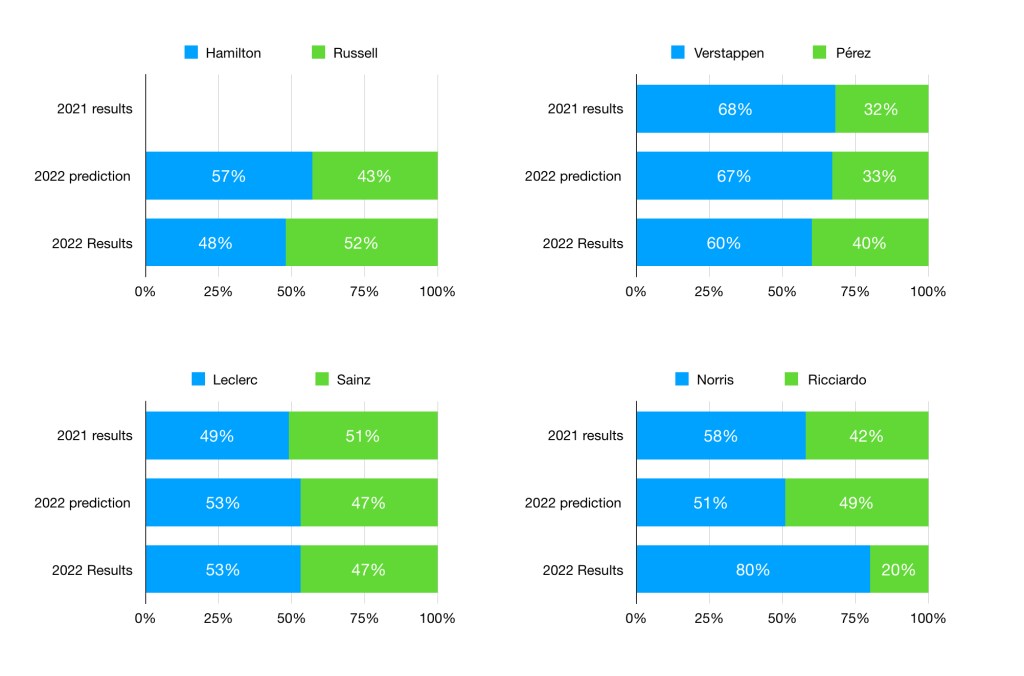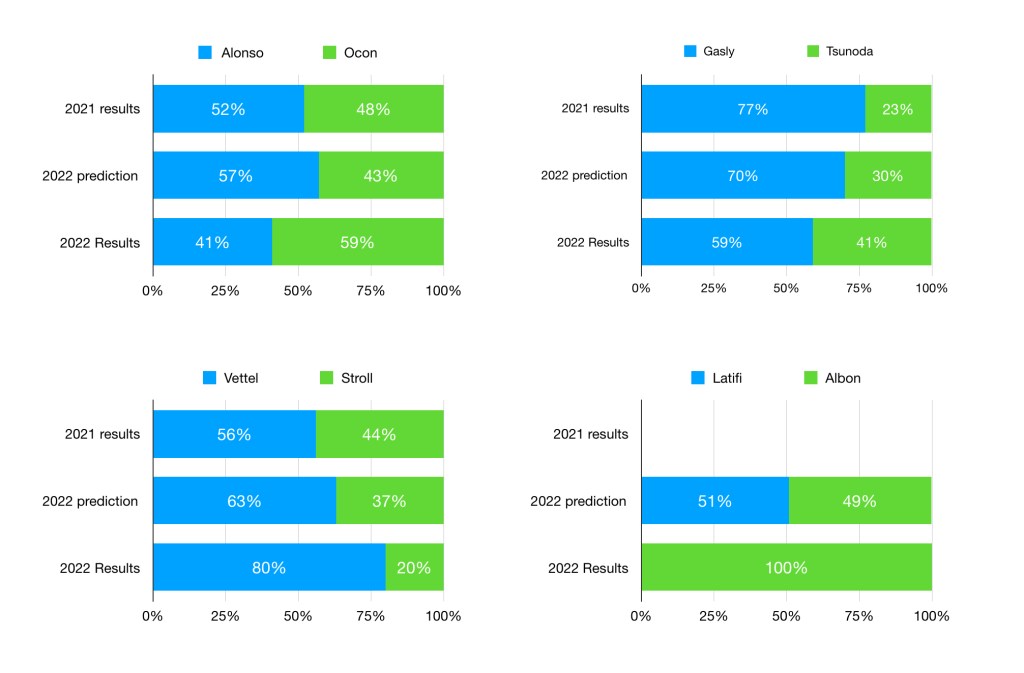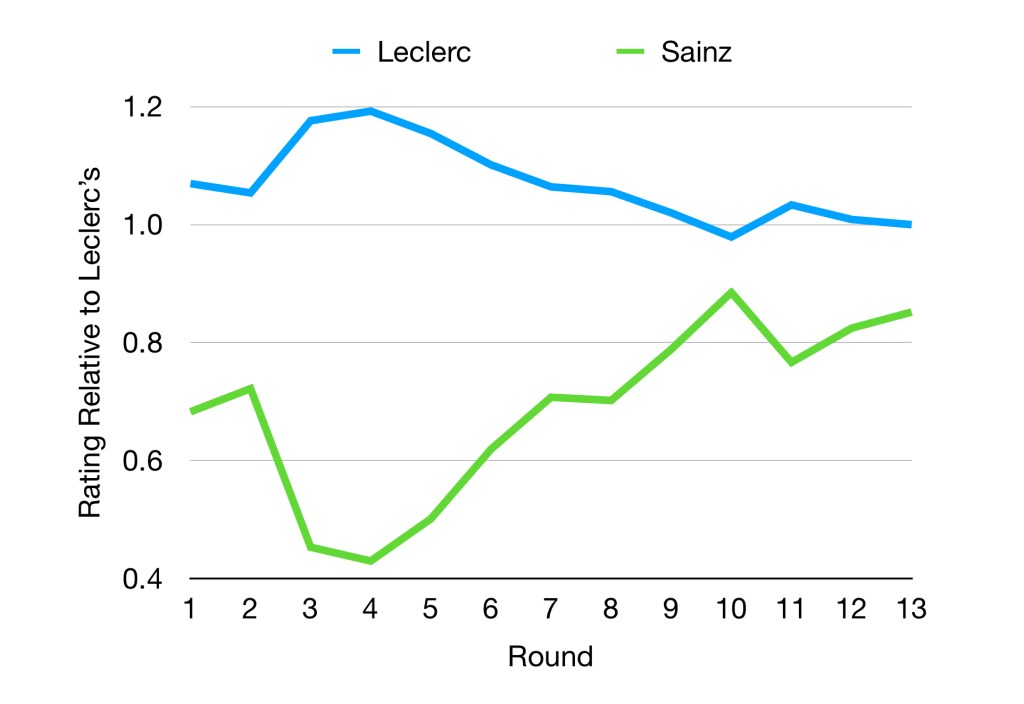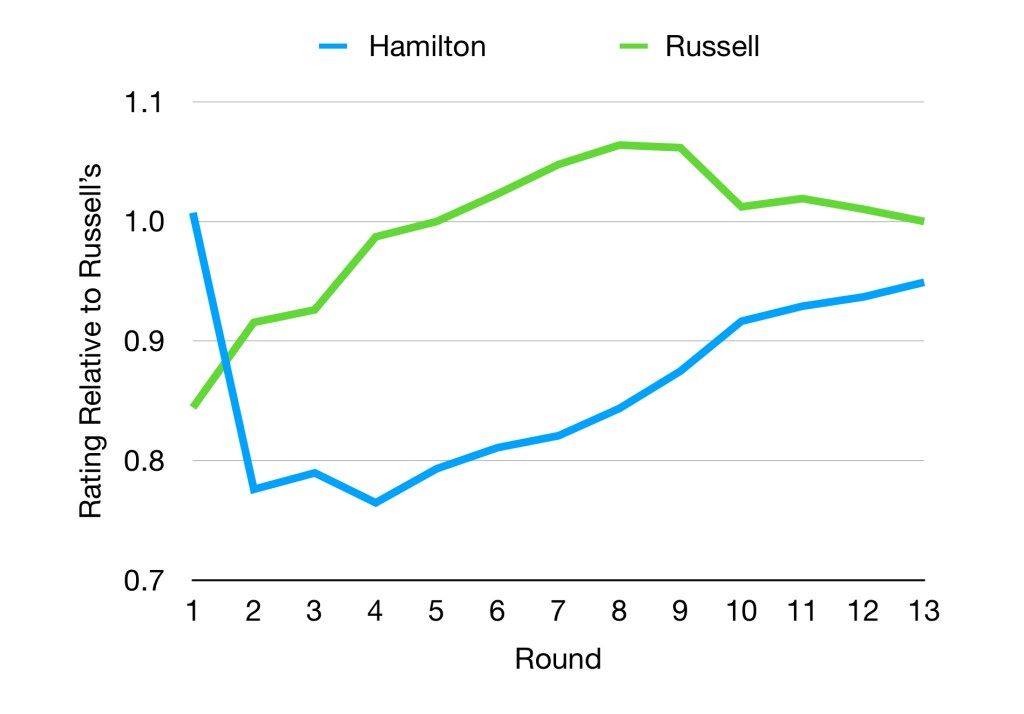See here for the final 2022 rankings
As we are now in the Summer Break, I thought it’d be worthwhile to see how the Mathematical Model has ranked drivers for 2022 so far, as well as the evolving trends over the 2022 season. For any new readers (welcome!), the model looks at results from the entire history of F1 to assess how strong each driver is based on their results versus their teammates. By doing this it can rate and rank drivers regardless of the car they drive.
Predictions vs Reality
Prior to the start of the season I posted some predictions of how teammates would perform against each other. So far, the predictions have been a bit of a mixed bag. Ferrari is actually totally accurate. Others are not exactly right but in the right direction relative to their 2021 results (Red Bull, AlphaTauri, Aston Martin). There a couple of dud predictions too, for various reasons (McLaren, Mercedes, Alpine and Williams). We’ll review again at the end of the year to see if anything’s changed.


There is a general trend that the more points a team has scored, the more accurate the prediction appears. This can be taken in a few different ways. Being generous to the model, more points means that freak results have less of an impact on the overall percentages, meaning the points scored are likely to be more reflective of their relative abilities.
A less generous interpretation is that the amount of variation is going to be a lot less in competitive teams (e.g. Albon has scored 100% of Williams’ points, but such a scenario would be basically impossible at Ferrari regardless of who the drivers were.)
General Trends in 2022
I thought it’d be useful to look at a couple of examples of how a driver’s career rankings have been adjusted due to 2022, how factors outside of their control (such as the performances of previous teammates) can cause adjustments, and some more general information of how the model works in practice.
Fall of Red Bull Academy Drivers.
Verstappen and Ricciardo have both underperformed (in terms of results relative to their teammates) compared to the model’s expectations, whilst Sainz’s rating this year has varied between achieving expectations and underperforming. As these 3 drivers are all linked via previous teammates, the lowering of one ranking is further fueling the lowering of the others too.
By comparison, the 2021 season did little be dampen Ricciardo’s overall ranking, as his poor results were somewhat insulated by Verstappen and Sainz exceeding expectations. (Although Ricciardo never partnered Sainz, the link to Norris important here).
The slight lowering of Verstappen and Ricciardo’s rankings has knock on effects for other Red Bull drivers such as Gasly and Albon. Whilst Albon has actually exceeded expectations in his comeback against Latifi, he has seen his career rating as a whole has actually decrease.
The changes in all of these driver’s overall ranking is not dramatic, given that half a season of additional data is not a lot. For example, the 2021 rankings are unchanged for Verstappen, Sainz and Tsunoda, with Ricciardo falling one place (to Russell) and Gasly being leapfrogged by Vettel.
Sainz’s 2022 Rating
This one is not much a trend but a good example of how the model works and how it corrects itself. There’s no doubt that Sainz’s 2022 season has been a mixed bag, and I know several people that have had changing opinions of the driver as the year has evolved. The model has also had changing opinions, with his results after 4 rounds being considered one of the least impressive on the grid (due to a couple of DNFs) before a remarkable turnaround. It’s surprising that Ferrari’s scores are the ones that (currently) match the 2022 prediction given how much their relative points have fluctuated due to unreliability and other factors.
The graph below shows how Sainz’s and Leclerc’s ratings are dependent of each other, with Sainz taking larger swings downwards/upwards than Leclerc due to the fact that the most likely explanation was considered to be Sainz underperforming relative to his ability. The idea that one driver’s score goes down as their teammate’s goes up is a core part of how the model works, and although the swing is quite extreme here the general principle is as expected. However, the model doesn’t always follow this simple rule of teammate dependency due to other factors (as we shall soon see).

Russell’s Growth
One of the big questions going into the year was how Russell would compare to Hamilton at Mercedes. There’s no doubt that Russell has fared remarkably well, and the model’s rating of him has correspondingly shot up due to how little data the model previously had.
The graph of Russell’s 2022 scores relative to Hamilton’s (calibrated so that Russell’s current score is equal to 1) conveys a lot if information.

The first surprise is that for many races both driver’s scores are increasing. How is this possible? Remember that the model has an overall rating for a driver’s total career that is then adjusted for a given season. Although the situation is complex, a simple explanation is that Hamilton’s score is increasing as his percentage of Mercedes’ points also increases.
Meanwhile Russell’s score is increasing due to the fact that the model’s overall perception of him as a driver is improving. You can also see that Russell’s score plateaued and then began to fall. This is partly due to Hamilton scoring the majority of Mercedes’ points in the last few rounds, and partly because the model’s correction of Russell’s abilities is probably mostly complete.
Another consequence of Russell’s strong results is that Hamilton’s career rankings have decreased slightly relative to the rest of the grid. As the scores are calibrated relative to Hamilton’s career (with a mean year for Hamilton equal to a score of 100%), this has the effect of raising almost every other driver’s ranking slightly ( the difference is less than 1 percentage point increase for most drivers).
Finally, let’s look at how Russell’s rise has affected Latifi, a driver that the model has always struggled to place due to a combination of a lack of experience, inexperienced teammates and unrepresentative results. Prior to this year, Latifi’s ranking was based solely on Russell’s, so Russell’s improving rating has seen Latifi rise as a driver too. This is despite a string of relatively poor results vs Albon in 2022, and Albon’s own ranking being lowered due to the aforementioned fall of Red Bull drivers.
Latifi’s career therefore provides some contradicting inputs, with his results across 2020-21 being surprisingly close to Russell’s. The model has (probably correctly) concluded that Latifi overperformed vs Russell (or to flip the argument, Russell failed to get the points at Williams that he should have done given his talent), but the exact extent of this is still being assessed.
Notes on Rookies and their Teammates
As Alfa Romeo are fielding a rookie driver, Zhou’s rated is dependent solely on this years comparison to Bottas, whilst Bottas’ ranking is unfortunately only based on his previous career.
A similar situation exists for Haas, whereby Schumacher has no comparison linked to the rest of the grid except for Magnussen. The general perception seems to be that both Bottas and Magnussen are performing above expectations. If this is true, it means that all 4 drivers will be underrated slightly by the model.
2022 Driver Rankings
C Tier
20) Zhou Guanyu, 42%
Zhou has shown a lot of potential, but has been lacking in terms of points. Despite this Alfa Romeo have been impressed by the Chinese driver, particularly in his ability to go through the steep learning curve of F1 whilst not having major crashes or mistakes that one that expect from a rookie.
One positive sign for him is that the 3 rookies of 2021 were the bottom 3 ranked drivers that year, emphasising the difficulty of adapting to Formula One. Once experience is taken into account, the model currently believes that Zhou has a slightly higher potential than all 3 of them.
Given all this, is the model being too harsh on Zhou by placing him last? Perhaps, but it lives and breathes by results, and he’s scored fewer than 10% of Alfa Romeo’s points. Whilst teammate Bottas has been performing well, few would consider him a top line driver and the model would expect any other current driver to have scored more points in the car.
19) Mick Schumacher, 54%
Schumacher had a lot going for him at the start of the season, after gaining experience, easily outpacing his teammate in 2021 and finding himself with a much more competitive car. However, the start of the 2022 season was poor, with several mistakes that are particularly costly during the current cost cap era. His lack of points was also holding Haas back in the constructors championship.
Much improved form and confidence in the last few races have ended questions about whether he is F1 material, and delivered an obvious jump in his rating too (see graph below), even if it’s yet to translate into a boosted position. Like Zhou, his current scoresheet vs a non-top tier driver is disappointing on paper, but the trend for both of them is probably upwards.
B Tier
18) Kevin Magnussen, 62%
Drafted in at the last minute for due to global geopolitics, Magnussen instantly impressed, scoring points in 3 of the first 4 races. As he’s facing a driver with no connection to the rest of the grid, there is little room for the model to fully assess how impressive his results are. Unfortunately the model does rate his previous efforts as particularly spectacular, which fixes him stuck in the bottom half for the remainder of the year.
N/A Nico Hülkenberg, 66%
Although he didn’t score any points, Hülkenberg did a solid job standing in for a COVID Positive Vettel at the start of the year. He’s still more than good enough to secure an F1 drive, but is unlikely to ever get another permanent seat.
17) Nicholas Latifi, 68%
As previously mentioned, the model has generally found it hard to place Latifi, due to his results being much more impressive against Russell then they had any right to be. His 2022 ranking has been consistently in the bottom third, but is still probably higher than many others would place him. Although the car is uncompetitive, teammate Albon has scored points and finished in the top 13 8 times, something Latifi has only managed thrice.
16) Lance Stroll, 69%
Stroll’s results have been fairly consistent this year, regularly hovering between 10th and 13th. He compared relatively well to Nico Hülkenberg (who of course had a significant disadvantage of being drafted in at the last second), but versus Vettel he’s generally been slightly adrift. He’s still doing a respectable job given that he’s often labelled as merely a pay driver though, and has shown in the past that he can deliver more if the car improves.
15) Yuki Tsunoda, 72%
After a tough first year, the Japanese driver has looked more sure footed in 2022. Tsunoda has been delivering more consistent results for AlphaTauri and has been noticably closer to teammate Gasly than in 2021. He’s earnt his place within F1, but withdrawal of Honda and the renewal of Perez’s contract at Red Bull raise questions about his long term career path, even if he can keep delivering results.
14) Daniel Ricciardo, 73%
There was a perception at a tail end of 2021 that Ricciardo was making progress with McLaren and would be able to take the fight to Norris this year. Indeed, the model predicted an even fight if both of them had typical seasons. Instead we’ve seen Ricciardo struggle at least as much as in 2022. Recent points results suggest there may be light at the end of the tunnel, but he’s still trailing Norris consistently.
Whist there’s been no official suggestion about Ricciardo leaving McLaren or F1, the choice of words in interviews suggest it may be a possibility. If so, it would be a great shame to lose a driver that, up until recently, the model ranked as within the top third of the grid.
13) Valtteri Bottas, 75%
After losing his Mercedes seat, Bottas moved to Alfa Romeo, a team that scored just 13 points last year. Both Alfa and Bottas have impressed in 2022, with the Finnish driver easily overhauling his team’s 2021 total single-handedly within 4 races. He’s also reminded people what a great qualifier he is with several well deserved Q3 appearances.
Like Magnussen, the fact that his teammate is a rookie means there’s little scope for an adjusted rating. If Bottas and Magnussen are performing better than expected, it may suggest that Zhou and Schumacher are not as far from the rest of the pack as their current positions suggest.
12) Fernando Alonso, 77%
Whilst the model has been very enthusiastic about Alonso’s career as a whole, his ranking in the bottom half is a reminder that it is fundamentally results dependent. The reality is that Ocon has more points, against expectations. Fernando has certainly had some bad luck that contributed to this, and said in Austria that he had lost 60-70 points through no fault of his own. Whilst such a figure is probably an exaggeration, his rating is steadily improving as the season progresses. The quick recovery of Sainz also demonstrates that drivers can quickly recover from poor results if the model deems those results to be unexpected.
11) Pierre Gasly, 79%
Gasly’s has had a largely successful period at AlphaTauri following his demotion from Red Bull in 2019. His 2022 season has definitely been quieter due to a less competitive car, and whilst Tsunoda has been closer than in 2021, Gasly is still the lead driver. Azerbaijan (where he qualified 6th and finished 5th) is an obvious highlight.
A Tier
10) Sergio Pérez, 82%
Despite winning a race in 2021, Pérez was rarely challenging teammate Verstappen. In 2022 he has been significantly closer. This time last year he had just 2 podiums (and 5 across the whole season). This year, he has 6 podiums already, and at times it looked like his form could even create headaches for Red Bull.
Recently his rating has been falling to a more expected level, and Verstappen now been inching out a significant points lead once again, but there’s no doubt that Pérez has had a strong first half to a year.
9) Alex Albon, 86%
Williams have not made the leap forward that may have been expected of them due to the 2022 rule changes, but Albon has had a strong return to the sport. He’s only once finished behind teammate Latifi (in Spain) and has twice snatched points when they were on offer. Considering he was dropped by Red Bull in favour of Pérez, his rating in the top half of the grid (and ahead of the Mexican driver that took his spot at Red Bull) is impressive.
8) Esteban Ocon, 86%
It’s been an impressive run from the Frenchman that’s justified why Alpine wanted to secure his services last year. His “perfect” weekend in Austria netted 5th place, which says more about Alpine’s midfield position than their top scoring driver. Given that Alonso has had the lions share of the bad luck at Alpine, it’s possible that Esteban’s ranting will fall slightly as the season progresses. Indeed, his rating has been slowly trending downwards. However, his score has been one of the most consistent on the grid up until now.

Hey! I really like your content!
Just a heads up: you need to do something about the posts layout. The “pages” links at the bottom are barely visible and didn’t find out they exist until just now (I used to just click on the index links to see the rest of the content).
LikeLiked by 1 person
Hi, Thanks for the feedback.
I’m looking at making improvements so the site, so this is very helpful to know.
LikeLike
Pingback: 2019 Driver Rankings – F1 Analysis
The model needs to consider mechanical issues and being crashed out. I know it will be much more work but ranking Latifi above Zhou let alone others is ridiculous. Points alone is not the end of story like I mentioned in Senna vs. Prost points comparison, Prost was not on Sennas level if thier MP45s are equally reliable.
LikeLike
I will be adding a comparison including this in the 2022 full year review. However, my initial analysis suggests that it will not have a particularly big impact on the rankings.
You mention Latifi and Zhou, which is mainly due a combination of Russell’s underwhelming results at Williams and Zhou’s lack of results this year (particularly when the car was more competitive). For now, Latifi’s score is continuing to inch down and Zhou’s is inching upwards, so we’ll have to see how things stand at the end of the year.
LikeLike